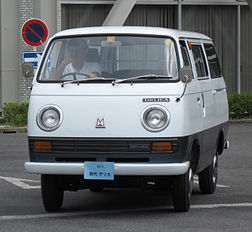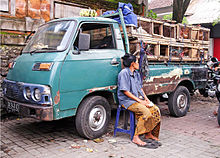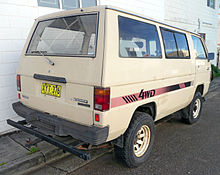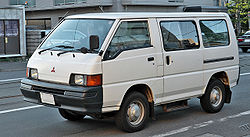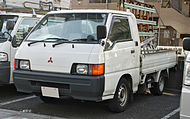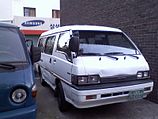- Mitsubishi Delica
-
Mitsubishi Delica 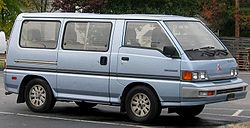
Manufacturer Mitsubishi Motors Production 1968–present Body style Truck
Van
People carrierThe Mitsubishi Delica is a range of trucks and multi-purpose vehicles (MPVs) built by Mitsubishi Motors since 1968. It was originally based on a small pickup truck introduced the previous year, also called the Delica, its name a contraction of the English language phrase Delivery car.[1] This truck, and a commercial van derived from it has received many names in export markets, being sold as the L300 (later L400) in Europe and New Zealand, Express and Starwagon in Australia, and plain Mitsubishi Van and Wagon in the US. The passenger car versions were known as Delica Star Wagon from 1979 until the 1994 introduction of the Delica Space Gear, which became simply Space Gear in Europe at least. The most recent version (not available as a commercial vehicle) is called the Delica D:5.
In Japan, the Delica Cargo nameplate was used on badge-engineered Mazda Bongos between 1999 and 2010. Since 2011, the Delica D:2 name has been applied to a rebadged Suzuki Solio.
Contents
First generation (1968)
First generation Also called (Mitsubishi) Colt T100/T120 Production 1968–1979 Assembly Japan: Nagoya Body style 3-door van
2-door pickupEngine T100: 1.1 L (1,088 cc) I4 KE44
T120: 1.4 L (1,378 cc) I4 4G41The production of the Delica light commercial cab-over pickup began in July 1968.[2] It received the chassis code T100, in line with the recently (January 1968) introduced "T90" Canter. Using a KE44 1,088 cc engine producing 58 PS (43 kW), its maximum payload was 600 kg (1,323 lb) and had a top end speed of 115 km/h (71 mph). A year later, in line with consumer needs, a cargo van and a passenger van were added to the lineup. The passenger van, discontinued in 1976, was called the 'Delica Coach' and could seat nine people in three rows of seats. The engine was later upgraded to 62 PS (46 kW).
In March 1971 a slightly facelifted version, called the Delica 75, arrived. This (the T120) received a small grille rather than the naked metal front of the earliest Delicas, and a new 1.4-liter Neptune (4G41) engine rated at 64 kilowatts (86 hp) was added to the lineup. The smaller 1.1-liter engine may have remained available in a 600 kilograms (1,300 lb) version of the truck but soon vanished entirely.[3]
After a fall 1974 facelift, the Delica received a new nose with lots of plastic cladding and double headlights, now mounted beneath the swage line. It was now known only as the "Delica 1400", as this was the only engine with which it was available (mention of a Delica 1200 is most likely apocryphal, perhaps an issue of confusion arising from the "120" chassis code). A longer wheelbase (T121) 1-ton truck was added in 1976.[3]
In export markets, this car was sometimes called simply the Colt T100 / T120.
Second generation (1979)
Second generation 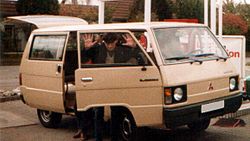
1979–1983 Mitsubishi L300 wagon, GermanyAlso called Chrysler L300 Express (AU)
Ford Husky (ZA)
Mitsubishi Colt Solar (RI)
Mitsubishi L300
Mitsubishi L300 Express (AU)
Hyundai Porter
Mahindra Voyager (IN)Production 1979–1986 Assembly Japan: Nagoya, Japan
Indonesia: Jakarta
South Korea: Ulsan
Philippines: Cainta, RizalBody style 2-door pickup
4-door van/wagonEngine 1.4 L I4 (gasoline)
1.6 L I4 (gasoline)
1.8 L I4 (gasoline)
2.0 L I4 (gasoline)
2.3 L I4 (diesel)
2.5 L I4 (diesel)Transmission 3-speed automatic
4-speed manual
5-speed manualWheelbase SWB: 2,200 mm (86.6 in)
LWB: 2,350 mm (92.5 in)Length SWB: 4,100 mm (161.4 in)
LWB: 4,260 mm (167.7 in)
Van: 4,445 mm (175.0 in)Width 1,690 mm (66.5 in) Height 1,990 mm (78.3 in) The Delica series was replaced in June 1979 by an all new design, bringing overall width up to the maximum 1,690-millimetre (67 in) dictated by Japanese regulations for "compact" vehicles.[4] Suspended at the front by an independent wishbone construction and a leaf spring at the rear, the Delica also features a sliding side door and one-piece gas strut tailgate.[5] The line-up was expanded to include ten model variations encompassing a wide variety of passenger (eight-seater in thrree/two/three configuration[6]), cargo and recreational applications. A four-wheel drive option was made available in 1982, a first in the Japanese van market. Engines were all four-cylinders well known from MMC's passenger cars and included the 1,439 cc, 80 PS (59 kW) Saturn (4G33) and 1.6-liter Saturn (4G32) engines. A 1.8-liter Sirius (4G62) version producing 100 PS (74 kW) appeared in May 1980, and a 2.0-liter Sirius (4G63B) petrol version became optional in 4WD versions from November 1983.[7] A 2.3-liter Astron (4D55) diesel appeared in October 1982 and was replaced by the larger 2.5-liter Astron (4D56) in 1986.
The four-wheel drive version of the Delica was first introduced to the Japanese market in October 1982.[7] This versatile vehicle utilized a modified version of the Mitsubishi Pajero's chassis, albeit usually with smaller engines (originally only the 1.8-liter gasoline).[6]
Market
- Australia
Chrysler Australia introduced the SA series Delica to the Australian market in April 1980 under the name "Chrysler L300 Express".[6] After acquiring control of the Chrysler Australia operations in the same month,[8] Mitsubishi Motors renamed the firm Mitsubishi Motors Australia in October 1980.[9] This resulted in the rebranding of the L300 Express as a Mitsubishi.[6] Fitted with a 1.6-liter engine and four-speed manual, both van (three-seater commercial) and wagon (eight-seater) variants were offered, with the commercial (van) version available with or without side rear windows.[6][10] The utility (pickup) version was not sold in Australia, as the L200 Express covered that segment of the market.[6] In November 1981 the SB series was introduced, now fitted with radial ply tires on larger diameter wheels, thus increasing the payload capacity from 925 to 1,000 kilograms (2,040 to 2,200 lb).[6] The following month, Mitsubishi introduced the high-roofed luxury "Deluxe" trim, fitted with electric sunroof and cloth upholstery.[6] The next update to the SB series arrived in October 1982, resulting in the "Deluxe" trim being renamed "Starwagon" and gaining a larger 1.8-liter engine—offered with a five-speed overdrive manual or optional three-speed automatic.[6] Mitsubishi extended the availability of the 1.8-liter engine to the lower-specification variants, albeit, in automatic guise only.[11]
From May 1983, the L300 Express received rectangular headlights in chrome surrounds as part of the SC iteration.[6] The SC also featured newly-designed black resin bumpers and adjustments to the front suspension spring rate to improve ride and handling.[12] The four-wheel drive version, badged "4WD", came in October 1983 as a 1.8-liter model with floor-mounted five-speed manual only, therefore becoming a seven-passenger model by losing the front-row center seat.[6][13] After another facelift in late 1984, the car became the SD series, introducing better equipment and black headlight surrounds along with a black trim piece between the headlights on "Starwagon" and "4WD" trims.[14][15] The SD revision also upgraded the "4WD" to a 2.0-liter engine, with the 1.8-liter standard issue in a new long-wheelbase commercial (van) model.[14] A final minor update, the SE series appeared in 1986.[16]
- Asia
This generation has been production in the Philippines since 1987 as the "Mitsubishi Versa Van" as well as the Cab/Chassis wherein local body builders assembles the rear bodies such as Almazora, Centro and Metro Truck for passenger and cargo hauling purposes. Variations such as the FB (Family Business), PET (Personal and Equipment Transport), WT (Water Tight Aluminum Van) and DS (Drop Side) have been made to cater to those needs. In 2010, an extended length chassis was added to the line up known as the L300 Exceed primarily for the L300 FB variant.
This generation is still in production in Indonesia as the "Mitsubishi Colt Solar L300",[17] equipped with the 2.5-liter 4D56 diesel engine.
In South Korea, Hyundai built the second generation Delica as the "Hyundai Porter", replacing an earlier model with the same name. South Korean production of this Porter continued alongside the third generation Delica, which was marketed by Hyundai as the "Grace". This Porter was replaced by an indigenously developed third generation Porter in March 1996.
From 1997 to 2000, the car was sold by Mahindra & Mahindra in India as the "Mahindra Voyager", but priced too high it was taken out of production after only a little over two years. The Voyager did meet with some success as an ambulance, but this association only further prevented prospective private purchasers.[18]
Third generation (1986)
Third generation Also called Mitsubishi L300
Mitsubishi Express (Australia)
Mitsubishi Starwagon (Australia)
Mitsubishi Versa Van
Mitsubishi Van/Wagon (US)[17]
Dodge 1000 (Mexico)
Hyundai Grace
Hyundai H-100Production 1986–present Assembly Japan: Nagoya
Indonesia: Jakarta (Indobuana Autoraya)
Philippines: Cainta, Rizal
South Korea: Ulsan
Taiwan (CMC)
Venezuela: Caracas[19]Body style 2-door pickup
4-door vanLayout Mid engine, rear-/four-wheel drive Platform P01V–P35W Engine 1,439 cc 4G33 I4 (gasoline)
1,597 cc 4G32 I4 (gasoline)
1,795 cc 4G62 I4 (gasoline)
1,997 cc 4G63 I4 (gasoline)
2,351 cc 4G64 I4 (gasoline)
2,476 cc 4D56 I4 (t/c diesel)Transmission 4-speed auto
5-speed manualWheelbase 2,235–2,435 mm (88.0–95.9 in) Length 4,380–4,780 mm (172.4–188.2 in) Width 1,690 mm (66.5 in) Height 1,840–1,955 mm (72.4–77.0 in) In June 1986 the Delica underwent its third full model change. More aerodynamic than previous versions, its monocoque body and extensive safety features proved very popular in Japan's fast-growing recreational vehicle market segment. The more rounded design was referred to as "soft cube" styling by Mitsubishi.[20] Passenger versions continued to be sold as Delica Star Wagons, which became just plain "Starwagon" in Australia. The commercial version is called the "Express" in Australia.
Although the subsequent L400 Delica and Delica Space Gear were introduced in 1994, the L300 Delica (van versions only) still remained in production in 2007 for export markets.[21] In Japan the commercial Delica range was replaced by a badge-engineered Mazda Bongo under an OEM deal which began in November 1999. However, as of 2011, the commercial version of the third generation Delica remains on sale in Australia where it retains the "Mitsubishi Express" badge.
A large range of engines were available, from a 1.4-liter up to a 2.4-liter petrol, and also a 2.5-liter diesel and turbodiesel. Rear- or four-wheel drive, several bodystyles and two different wheelbases made for a particularly extensive lineup. The four-wheel drive chassis was based on that of the contemporary Mitsubishi Pajero, although parts are seldom interchangeable.
Market
- Asia
Cargo versions are built by the China Motor Corporation in Taiwan.[22] This generation Delica was also built under license by Hyundai of South Korea, where it was called the "Hyundai Grace" or "Hyundai H-100" in some Eurasian markets. Launched in December 1986, this version originally received the twin headlights as used in the US market versions, but after a front-end facelift the new more aerodynamic version received thinner and more rounded headlights. This version was called the "New Grace". Both the 2.4-liter gasoline and 2.5-liter turbodiesel inline-four engines were available, both Mitsubishi designs. Hyundai terminology resulted in the 4D56 diesel engine being renamed D4BX / D4BA.
- North America
From 1987 until 1990, Mitsubishi sold this model in small numbers in the United States as the "Wagon" for passenger versions and "Van" for windowless cargo versions.[23] The US versions all received a 107 horsepower (80 kW) version of the 2.4-liter 4G64 engine. For model years 1990 and 1991 an LS version of the Wagon was added.[24] Taiwanese-produced CMC Delica vans are sold in Mexico as the Dodge 1000[25] as of July 2007.[26]
Fourth generation (1994)
Fourth generation Also called Mitsubishi L400
Mitsubishi Space Gear
Mitsubishi Starwagon (Australia)Production 1994–2007 Assembly Japan: Nagoya Engine 2.5 L 4D56 I4 (t/c diesel)
2.4 L 4G64 I4 (gasoline)
2.8 L 4M40 I4 (t/c diesel)
3.0 L 6G72 V6 (gasoline)Transmission 4-speed automatic
5-speed manualWheelbase 2,800–3,000 mm (110.2–118.1 in) Length 4,595–5,085 mm (180.9–200.2 in) Width 1,695 mm (66.7 in) Height 1,855–2,070 mm (73.0–81.5 in) Curb weight 1,690–2,170 kg (3,700–4,800 lb) 1994–1996
Released on May 12 1994, the newest Delica received considerably more aerodynamic bodywork. No truck model was available of this generation, and passenger models were now called Delica Space Gear in the domestic Japanese market. Body specifications of the Space Gear in Japan ranged from XR, XG, Exceed, Super Exceed and Royal Exceed, and both long and short-wheelbase versions were available.
The fourth generation Delica is based on the chassis of the Mitsubishi Pajero[citation needed] and has full off road capabilities, with four-wheel drive, high and low ratio gears and differential locking. It has engine variations from 2.5 liters through to a 2.8-liter intercooled turbodiesel. A 2.4-liter and a 3.0-liter V6 petrol engine with 12 or 24 valves, each with 4 gears and overdrive. Apart from the 2.8-liter diesel model they are available as a two or a four wheel drive version.
In many export markets, the cargo versions of the fourth generation were called the Mitsubishi L400 while the passenger versions were called Mitsubishi Space Gear – without using the Delica nameplate at all.
In Australia, where this generation was only available as a passenger version, it retained the "Mitsubishi Starwagon" name and was available between September 1994 and 2003. These Australian models were made available in four levels of specification: GL, GLX, GLS and 4WD.[27] Mitsubishi fitted the GL with a 2.0-liter carburetored inline-four, with the GLX gaining a fuel-injected 2.4-liter inline-four, and the GLS a 3.0-liter V6. Both four-cyliner engines were fitted standard with a five-speed manual transmission with optional four-speed column-shift automatic. The 3.0-liter GLS offered a four-speed floor-mounted automatic as its sole transmission option. The facelift model, released in 1996 saw the range rationalised with only the base GL and mid-range GLX models retained.
1996–2007
In 1996 the Delica was upgraded with a facelift model. The upgrade is mostly cosmetic with changes to the lighting clusters and front bodypanel, with the integration of a moulded bumper in place of the original three section bullbar. The engine was upgraded with an electronic control type distribution type jet pump and an electronic sidestep was made standard on the higher specification versions.
Fifth generation (2007)
Fifth generation (D:5) 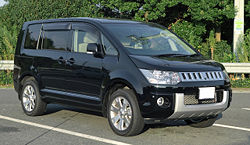
Production 2007–present Engine 2.4 L 4B12 I4 (gasoline) Transmission CVT INVECS-III automatic On October 30, 2006 Mitsubishi Motors announced that the next generation of its monobox minivan would be called the Delica D:5, based on the Concept D-5 prototype first exhibited at the 39th Tokyo Motor Show in 2005.[28] It is an eight-seater, that features Mitsubishi's AWC four wheel drive system and an INVECS-III continuously variable transmission, coupled to a 4B12 2.4 L MIVEC straight-4 engine. Based on a new global GS platform, new Delica features Mitsubishi's next-generation RISE safety body.
It was released in Japan on January 31, 2007, with prices ranging from ¥2,614,500 to ¥3,412,500.[29]
Other models using the "Delica" name
Main articles: Mazda Bongo and Suzuki Wagon RBetween November 1999 and 2010, Mitsubishi retailed a rebadged version of the Mazda Bongo as the "Delica" in Japan, replacing the cargo version of the fourth generation Delica in that market.
To complement the Delica D:5, a smaller "Delica D:2" model appeared in March 2011. Equipped with a 1.2 L (1,242 cc) four-cylinder Suzuki K12B engine and a CVT transmission, the car is a rebadged Suzuki Solio provided under an OEM deal.[30] The Solio is the most recent version of a family of cars which began life as a widened Wagon R.
1999–2010 Mitsubishi DelicaMain article: Mazda Bongo2011 Mitsubishi Delica D:2Main article: Suzuki Wagon RProduction
Year Japan Philippines Taiwan China 1995 109,930 n/a n/a 1996 88,978 n/a n/a 1997 69,495 n/a n/a 1998 34,614 n/a n/a 1999 17,758 n/a n/a 2000 28,242 2,918* 8,125 2001 12,965 2,079* 5,133 690 2002 17,456 2,925* 4,192 600 2003 13,011 3,529* 5,166 13,710 2004 16,432 2,826* 3,862 16,074 2005 16,444 3,685* 2,315 5,960 2006 16,041 3,992* 1,160 – 2007 14,824 4,580* 1,115 – *L300 only.
(Sources: Facts & Figures 2000, Facts & Figures 2005, Facts & Figures 2008, Facts & Figures 2010 Mitsubishi Motors website)
References
- ^ Fact & Figures 2005, p.33, Mitsubishi Motors website
- ^ Ozeki, Kazuo (2007) (in Japanese).
日本のトラック・バス 1918~1972 [Japanese Trucks and Buses 1918-1972:]. Tokyo: Miki Press. p. 113. ISBN 978-4-89522-494-9. - ^ a b Kazuhiko. "初代デリカ(T系) [First Delica (T-series)]" (in Japanese). Delica History. http://heartland.geocities.jp/kazuhiko0521/delica/delica-history-syodai.htm. Retrieved 2011-04-28.
- ^ "Delica 1979". Mitsubishi Motors Web Museum. http://www.mitsubishi-motors.com/corporate/museum/products/1970/e/popup/029_delica.html. Retrieved 2010-10-30.
- ^ McKay, Peter (June 1980). "Chrysler launches rival for Kombi". Modern Motor (Rushcutters Bay, New South Wales: Modern Magazines (Holdings)): 15. http://www.archive.org/download/ChryslerLaunchesRivalForKombi/ModernMotor1980-06.pdf.
- ^ a b c d e f g h i j k Mills, Andrew (November 1984). "Mitsubishi L300 Express: The Trendsetter". Modern Motor (Sydney, New South Wales: Australian Consolidated Press): 90–92. http://ia600606.us.archive.org/18/items/MitsubishiL300ExpressTheTrendsetter/ModernMotor1984-11.pdf.
- ^ a b Car Graphic: Car Archives Vol. 11, '80s Japanese Cars. Tokyo: Nigensha. 2007. p. 226. ISBN 978-4-544-91018-6.
- ^ "Australia in the 1980s: Industry". My Place. Australian Children's Television Foundation and Education Services Australia. http://www.myplace.edu.au/decades_timeline/1980/decade_landing_2.html?tabRank=4&subTabRank=3. Retrieved 2011-04-30.
- ^ "Chrysler Australia". Unique Cars and Parts. http://www.uniquecarsandparts.com.au/history_chrysler.htm. Retrieved 2011-04-30.
- ^ "1980 Mitsubishi L300". CarBuddy. http://www.carbuddy.com.au/car/values/specification/default.aspx?mk=MITSUBISHI&md=L300&y=1980. Retrieved 2011-04-30.
- ^ Lake, Barry, ed (May 1983). "More power, auto for Express wagon". Modern Motor (Sydney, New South Wales: Murray Publishers): 13. http://www.archive.org/download/MorePowerAutoForExpressWagon/ModernMotor1983-05.pdf.
- ^ Lake, Barry (September 1983). "Improved L300 range". Modern Motor (Sydney, New South Wales: Murray Publishers): 13. http://www.archive.org/download/ImprovedL300Range/ModernMotor1983-09.pdf.
- ^ "1983 Mitsubishi L300". CarBuddy. http://www.carbuddy.com.au/car/values/specification/default.aspx?mk=MITSUBISHI&md=L300&y=1983. Retrieved 2011-04-30.
- ^ a b Britten, Tim, ed (November 1984). "L300 update". Motor Manual (Melbourne, New South Wales: Newspress): 8. http://www.archive.org/download/L300Update/MotorManual1984-11.pdf.
- ^ Britten, Tim, ed (March 1985). "Still king of the people movers?". Motor Manual (Melbourne, New South Wales: Newspress): 61–62. http://www.archive.org/download/StillKingOfThePeopleMovers/MotorManual1985-03.pdf.
- ^ "1986 Mitsubishi L300". CarBuddy. http://www.carbuddy.com.au/car/values/specification/default.aspx?mk=MITSUBISHI&md=L300&y=1986. Retrieved 2011-04-30.
- ^ a b "Facts & Figures, Mitsubishi Motors Corporation 2000". Section V (Current model lineup), page 6 (Naming in global markets). Tokyo: Mitsubishi Motors. September, 2000. p. 18. http://www.mitsubishi-motors.com/corporate/ir/share/pdf/e/fact0009.pdf. Retrieved 2010-10-30.
- ^ "Mahindra Voyager: RIP (1997-2000)". MarketingTypo.com. 2010-07-24. http://marketingtypo.com/2010/07/24/mahindra-voyager-rip-1997-2000/. Retrieved 2010-12-20.
- ^ Un aliado de su negocio hecho a la medida MMC Automoritz S.A.
- ^ "Notable MMC Cars". Mitsubishi Motors: Facts & Figures 2010. Mitsubishi Motor Corporation. 2010. p. 31. http://www.mitsubishi-motors.com/corporate/ir/share/pdf/e/fact_2010.pdf.
- ^ Mitsubishi Facts & Figures 2007 – Mizuma Plant (Japan) Sales figures by volume (Page 21)
- ^ "China Motor Corporation". Hoovers. http://www.hoovers.com/company/China_Motor_Corporation/rcsstxi-1.html. Retrieved 21 July 2011.
- ^ James M. Flammang (1994). Standard Catalog of Imported Cars, 1946–1990. Iola, WI: Krause Publications, Inc.. p. 447. ISBN 0-87341-158-7.
- ^ Mastrostefano, Raffaele, ed (1990) (in Italian). Quattroruote: Tutte le Auto del Mondo 1990. Milano: Editoriale Domus S.p.A. pp. 581–582.
- ^ miautoculiacan.com
- ^ "Ford Lio Ho Motor, Yulon Motor, China Motor in Taiwan planning to expand exports of complete vehicles". Mark Lines. http://www.marklines.com/en/report/rep625_200712. Retrieved 21 July 2011.
- ^ "Mitsubishi Starwagon GLX Car Review". NRMA. 3 December 1994. http://www.mynrma.com.au/motoring/reviews/car-reviews/mitsubishi/starwagon-glx.htm. Retrieved 2011-04-14.
- ^ "New Mitsubishi Motors mono-box minivan to be branded "Delica D:5", Mitsubishi Motors press release, October 30, 2006
- ^ "Mitsubishi Motors launches new Delica D:5", Mitsubishi Motors press release, January 31, 2007
- ^ "三菱自動車、『デリカD:2』 を新発売: ~5人乗り2列シートのコンパクトミニバン~ [Mitsubishi New Release, Delica D:2 - 5 seats in 2 rows in a compact minivan]" (in Japanese). Mitsubishi Motors. 24-02-2011. http://www.mitsubishi-motors.com/publish/pressrelease_jp/products/2011/news/detail4442.html.
Categories:- Mitsubishi Motors vehicles
- Vans
- All wheel drive vehicles
- Vehicles introduced in 1968
Wikimedia Foundation. 2010.

